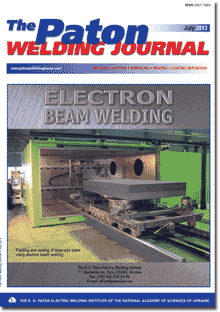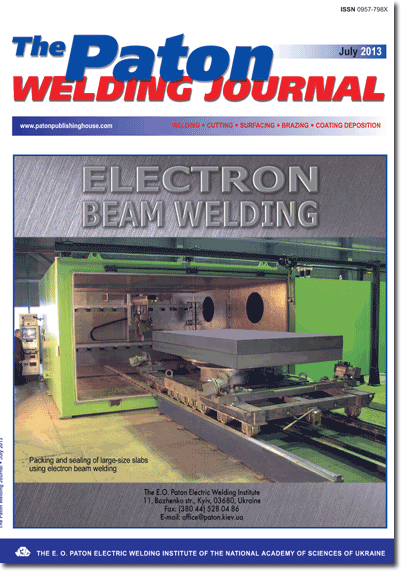| 2013 №07 (01) | 2013 №07 (03) |

The Paton Welding Journal, 2013, #7, 7-12 pages
FORMATION OF COLD CRACKS IN WELDED JOINTS FROM HIGH-STRENGTH STEELS WITH 350-850 MPa YIELD STRENGTH
L.M. LOBANOV, V.D. POZNYAKOV and O.V. MAKHNENKO
E.O. Paton Electric Welding Institute, NASU. 11 Bozhenko Str., 03680, Kiev, Ukraine. E-mail: office@paton.kiev.ua
Abstract
The main problems in welding of high-strength steels are connected with their susceptibility to cold crack formation. As a rule such cracks are nucleated in HAZ of welded joints under the effect of tensile stresses. Diffusible hydrogen and presence of hardening structures in metal accelerate this process. Given paper presents a comparative analysis of effect of structure, diffusible hydrogen and residual stresses on cold crack resistance of welded joints from high-strength structural steels differ in chemical composition and level of static strength. Experiment-calculation methods of investigation were used for study of microstructural changes and formation of stress-strain state in rigidly fixed welded joints. Resistance of welded joints to cold crack formation was evaluated based on results of testing of technological samples and specimens on Implant method. It was determined as a result of performed investigations that probability of formation of longitudinal cold cracks in rigidly fixed welded joints from high-strength steel changes in wide ranges. However, there are specific regularities related with effect of the residual welding stresses on this processes. Increase of diffusible hydrogen content in deposited metal, steel carbon equivalent, cooling rate and stress-strain state of welded joints reduce their cold crack resistance. Results of performed investigations can be used in development of technological processes of welding of high-strength steels with yield strength from 350 to 850MPa and carbon equivalent from 0.35 to 0.70%. 11 Ref., 4 Tables, 6 Figures.
Keywords: high strength low-alloy steels, welded joints, cold cracks, residual welding stresses, diffusible hydrogen, metal structure, preheating, heat-affected zone
Received: 30.05.13
Published: 28.07.13
References
1. Makarov, E.L. (1981) Cold cracks in welding of alloy steels. Moscow: Mashinostroenie.
2. Musiyachenko, V.F. (1983) Weldability and technology of welding of high-strength steels. Kiev: Naukova Dumka.
3. Hrivnak, I. (1984) Weldability of steels. Moscow: Mashinostroenie.
4. (1998) Welding handbook. Vol. 4: Materials and applications. Pt 2. Miami: AWS.
5. Magudeeswaran, G., Balasubramanian, V., Madhusudhan Raddy, G. (2009) Cold cracking of flux cored arc welded high strength steel weldments. J. Mat. Sci. and Technol., 25(4), 516-526.
6. Pokhodnya, I.K., Shvachko, V.I. (1997) Physical nature of hydrogen induced cold cracks in welded joints of structural steels. Avtomatich. Svarka, 5, 3-10.
7. Cwiek, J. (2007) Hydrogen degradation of high strength weldable steels. J. Achievements in Materials and Manufacturing Eng., 20, 223-226.
8. Makhnenko, V.I. (1998) Computater modeling of welding processes. In: Current materials science of 21st century. Kiev: Naukova Dumka.
9. Sayffarth, P., Kasatkin, O.G. (1982) Calculation of structural transformations in the welding processes. IIW Doc. IX-1288-82.
10. Makhnenko, V.I. (2006) Resource of safety service of welded joints and assemblies of current structures. Kiev: Naukova Dumka.
11. Lobanov, L.M., Mikhoduj, L.I., Vasiliev, V.G. et al. (1999) Peculiarities of running of thermodeformation processes in arc welding of high-strength steels. Avtomatich. Svarka, 3, 3-11.
Suggested Citation
L.M. LOBANOV, V.D. POZNYAKOV and O.V. MAKHNENKO (2013) FORMATION OF COLD CRACKS IN WELDED JOINTS FROM HIGH-STRENGTH STEELS WITH 350-850 MPa YIELD STRENGTH. The Paton Welding J., 07, 7-12.The cost of subscription/purchase order journals or individual articles
| Journal/Currency | Annual Set | 1 issue printed |
1 issue |
one article |
| TPWJ/USD | 384 $ | 32 $ | 26 $ | 13 $ |
| TPWJ/EUR | 348 € | 29 € | 24 € | 12 € |
| TPWJ/UAH | 7200 UAH | 600 UAH | 600 UAH | 280 UAH |
| AS/UAH | 1800 UAH | 300 UAH | 300 UAH | 150 UAH |
| AS/USD | 192 $ | 32 $ | 26 $ | 13 $ |
| AS/EUR | 180 € | 30 € | 25 € | 12 € |
| SEM/UAH | 1200 UAH | 300 UAH | 300 UAH | 150 UAH |
| SEM/USD | 128 $ | 32 $ | 26 $ | 13 $ |
| SEM/EUR | 120 € | 30 € | 25 € | 12 € |
| TDNK/UAH | 1200 UAH | 300 UAH | 300 UAH | 150 UAH |
| TDNK/USD | 128 $ | 32 $ | 26 $ | 13 $ |
| TDNK/EUR | 120 € | 30 € | 25 € | 15 € |
AS = «Automatic Welding» - 6 issues per year;
TPWJ = «PATON WELDING JOURNAL» - 12 issues per year;
SEM = «Electrometallurgy Today» - 4 issues per year;
TDNK = «Technical Diagnostics and Non-Destructive Testing» - 4 issues per year.


